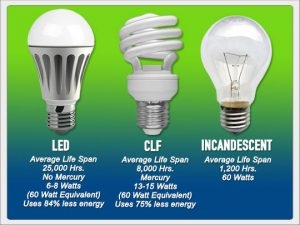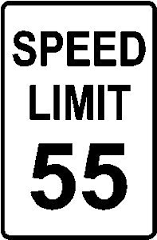So, you’ve already gotten a no-cost energy assessment, replaced your incandescent light bulbs with CFLs, and done follow-up insulation & weather-stripping work to improve your home’s energy efficiency. And you either have solar already or are not a good candidate for it. Can you do more? Below are some great ideas that you may not have heard about – check them out.
Around the House
- Come out of the dark. Switch to LED (light emitting diode) light bulbs. A 10-watt bulb can replace a 75-watt bulb and will last 50 times as long. Replacing an incandescent bulb with an LED bulb will save the Greenhouse Gas equivalent of 135 gallons of gasoline over the bulb’s lifetime.

- Leave it Off – Contrary to popular belief, it doesn’t take more energy to turn a light on and off than to leave it burning. If a room will be vacant for more than 5 minutes, turn the lights off. If you like to leave a light on for safety or reassurance, put an LED bulb in it so that’s operating at peak efficiency.
- Be a Draft Dodger! Is your home drafty? If so, up to 30% of your heat your may be escaping outdoors. A windy day is a good time to test for air leaks. Hold a lit incense stick (with a plate under it to catch the ash) or a damp hand next to your windows, doors, electrical outlets, attic hatch, and other seams, cracks, and openings to the outside. If the smoke stream moves horizontally or you feel a draft on your hand, you have located an air leak that may need caulking, foam sealing, or weather stripping. Sealing these leaks can be one of the easiest and most effective ways to save energy/money.
- Inspect each door for cracks between the door and the wall. If you see light coming from the other side, the door needs to be weather-stripped.
- If you have a drafty or cold north-facing window, install a window film – clear plastic that is sealed around the window using a hair dryer to shrink the plastic for a tight fit. Don’t forget your attic and basement windows!
- Light my fire … but close the damper. Sure the fireplace is romantic, but keeping your fireplace damper closed when no fire is going will save you big bucks! Open chimney dampers can add as much as 4 percent of your home’s heating bill. For an even tighter seal, you can cover the damper with cardboard and duct tape or purchase a “chimney balloon”. Just make sure to remove anything you put in the chimney and open the flue before lighting a fire.
- Go Backwards. Though we usually think of using fans to keep cool, they can also help you stay warm. Most ceiling fans have a switch that reverses the direction that the blades spin. Standard, counter-clockwise rotations create a cooling breeze for warmer weather. Reversing the fan so it spins clockwise, on the other hand, causes the warm air that pools near the ceiling (because heat rises, of course!), to circulate back down into your living space. Running your ceiling fan in reverse will help you enjoy the full effect of your home’s heat, and can actually save you up to 10% on heating costs this winter.
- Throw Cold Water On It – Water heating accounts for 90% of the energy used to clean your clothes in the washing machine. With modern detergents and technology, hot water washes probably aren’t needed to keep your clothes looking great. Try a cold or warm wash, which is gentle on fabrics and saves money and energy.
- Don’t be a drip. Wasting water wastes a precious resource and can cost you a great deal. Water waste also waste energy, since water needs to be pumped from the ground by electric motors. The US EPA estimates that the average household wastes more than 10,000 gallons per year through dripping faucets, running toilets and wasteful fixtures. At Needham’s water rates, that comes to over $200 per year. Most of these problems can be inexpensively solved with a trip to the hardware store, a screwdriver and a wrench.
- Cook and save.
- Save considerable energy by using your microwave oven and pressure cooker whenever possible. They cook quickly using less energy.
- Foods will cook faster and use less energy if you put lids on the pots and pans and make sure they’re the right size for the burner.
- Preheat the oven only when the recipe calls for it. There’s no need to preheat the broiler.
- Save energy by baking an extra dish or cooking entire meals in the oven at the same time
- When you open the oven door to peek at food inside you lose 25-75 degrees of heat. Look through the oven window or wait until the food is almost done before opening the door.
- If you have a self-cleaning oven, clean it immediately after use. Because it’s already hot, it will take less energy to get to the heat cleaning stage.

And are there additional ways that you can save money and energy on the road? You might be pleased to learn that there are driving practices that help you reduce energy usage while you are driving – check out the below driving tips.
On the Road
- Be a smoothie. Accelerating slowly from a full stop can improve your gas mileage by as much as two miles per gallon.
- Slow down! Driving at 75 mph uses 30% more gas than driving at 60 mph.
- Loose that extra weight! Every extra 100 pounds of junk in your car’s trunk costs you a half-mile per gallon.
- Keep inflation under control! When your car’s tires are improperly inflated, it not only shortens the life of your tires, but it also reduces gas mileage. It’s easy for your tires to get a few pounds per square inch (psi) below the proper level. (In fact, cold air makes the problem worse.) To check, simply pull up to your local station’s gauge once a month to check and adjust your pressure. Edmunds.com has a great “How To” video to get you started! You can find your tire’s optimum level illustrated on illustrated on your vehicle on the inside door panel.
- Don’t be idle! Think about it — idling gets you zero miles per gallon. The best way to warm up a vehicle is to drive it. No more than 30 seconds of idling on winter days is needed. Anything more simply wastes fuel and increases emissions.
- Don’t let drag get you down. Reduce drag by placing items inside the car or trunk rather than on roof racks, which can decrease your fuel economy by 5% or more.
Sources:
http://southcoastenergychallenge.org/category/your-home/
http://www.epa.gov/cleanenergy/energy-resources/calculator.html
http://www.epa.gov/WaterSense/pubs/fixleak.html
http://www.nstar.com/residential/energy_efficiency/
http://www.hribar.com/energy-saving-tips.htm
http://energy.gov/energysaver/articles/tips-transportation

